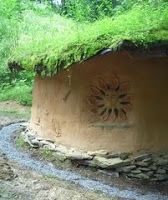We're in our dry season here in middle Tennessee. Of course, I use that term lightly. Paul, our most recent apprentice, would probably shake his head in amusement. He's from the Phoenix area, where it can go for months without rain. Around here, it's more like a couple of weeks at the most.
Last week, though, we had a lovely morning shower. The gentle rain woke me up to the soft sound of "sshhhhhhhh" as the droplets hit the surrounding trees. After feeding the chickens, ducks and my calico kitten Cleo, I picked up my little camera and headed out into the yard to get some pictures and video of the beautiful site. I hope you enjoy the resulting video.
Chronicling the adventures of ecovillagers, apprentices,
permaculturalists, natural builders, herbalists, inventors,
mechanics, cooks, artists, educators and facilitators at the
Ecovillage Training Center.
Thursday, August 12, 2010
Sunday, August 1, 2010
How to Beat the Summer Heat with Thermal Mass
 Well, it's official. It's August. The heat here is astounding, and the humidity is giving the heat a good run for its money. As we have no air conditioning in the old farm house that is the Ecohostel, we are not taking reservations this month.
Well, it's official. It's August. The heat here is astounding, and the humidity is giving the heat a good run for its money. As we have no air conditioning in the old farm house that is the Ecohostel, we are not taking reservations this month."But, surely people lived in the southern United States before air conditioning," you may exclaim. "It can't be that bad. And don't you have passive solar heating and cooling? Isn't your place a working model of how to create comfortable living spaces without the need for large, noisy, electricity-guzzling machines?"
"Yes!" We reply, to all of it. People did live here before air conditioning. n fact, people have lived here since before Europeans landed on this continent. What did they do to keep cool? They built for the heat. The Cherokee of the area built wattle-and-daub dwellings for the summer, taking advantage of the temperature regulating properties of earth. The European settlers of the area used techniques such as tall ceilings that allowed hot air to rise above head height, and front porches with big overhanging roofs for shade to beat the heat.
Today, people around here have forgotten how to build for their climate. The cheap energy we so enjoy here allows developers and architects to design houses with no consideration for working with the environment. Instead, the modern thought is to create a sealed off, air tight building, then pump it full of machine regulated air.
The buildings here at the Ecovillage Training Center work a little differently. Take the Hippitat, for example. It's a small, one room sleeping cabin built using a natural building technique called earthbag. Long tubes of bags are filled with earth, and stacked on top of each other to create the wall structure. These bags are then covered over with a beautiful natural plaster. These bag walls act like a constructed cave, keeping the inside temp cool in the day and warm at night.
The bags of earth do not insulate, which is a way of stopping the tranfer of heat by creating air pockets. Instead, they maintain comfortable temperatures through thermal mass. During the day, the mass of the thick walls is struck by the hot sun. The walls heat up, but very slowly. While the outside of the walls are heating, the inside surface of the walls stay nice and cool. So many visitors comment on the rush of cool air that meets them when they open the door to this little builing. Even during the peak of a summer day, when the outside temperature is 90 - 100 degrees Farenheight, the inside of the Hippitat is lovely and cool.
By sun down, the warmth that has been collecting in the walls all day is slowly released into the inside of the building. Fortunately, this area of Tennessee has cool nights suring the summer. Even now, when we are baking during the day, the nights usually dip back down into the 70's. The walls of the Hippitat get a chance to release the heat that's been slowly moving through them, and create a cozy sleeping environment just warm enough to relax you to send you off to dream land. Then, in the morning, after they have released the heat of the previous day, they are ready to do it all over again.
And that's just one example of how we work with nature to heat and cool our buildings. We uatlize passive solar techniques in our EcoHostel, and natural insulation techniques such as straw clay slip and strawbales in some of our other buildings. A few of our buildings even have living roofs, a technique that allows you to safely grow plants on the roof of your house!
You don't have to grow a forest floor on your roof to take advantage of energy-reducing building techniques, though. Simple passive solar techniques, such as large windows on the south side of the house (in the norther hemisphere) will help heat the house during the winter. Having a fan in the attic to push out the rising hot air can save you money on air conditioning bills in the summer. To learn more about ways to design a house that heats and cools itself, hop on over to the Passive Solar Building Design wikipedia article.
Subscribe to:
Posts (Atom)